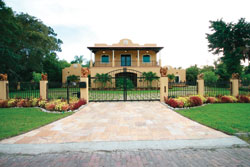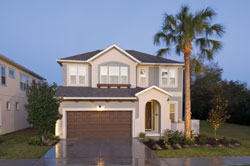
Signature Built Homes are safer because they use storm-resistant materials and technologies.
Green Florida: Blowing in the Wind
There were only a few buildings left standing after the storm—but? among them were 10 homes in the community of Audubon Village.
For those of us who live in Florida—a state that has had more than its share of hurricanes over the past several years—the survival of those homes should be of great interest.
Here’s why. The homes had been built using storm-resistant guidelines from a program run by the Institute for Business and Home Safety (IBHS), a Tampa" target=_blank>Tampa-based nonprofit organization supported by the insurance industry.
The Institute’s Fortified for Safer Living program focuses on helping builders construct stronger, more disaster-resistant structures. And when Ike struck, the Texas homes clearly “performed better than the houses around them,” says Dr. Tim Reinhold, IBHS senior vice president of research and chief engineer.
Three of the fortified homes in Audubon Village were destroyed during the storm. However, Reinhold says, the damage likely came from being hit by debris from unfortified homes nearby.?
In the aftermath of the hurricane, the Fortified for Safer Living program, which was launched in 2000 with three homes in the Tampa" target=_blank>Tampa Bay area, garnered national attention.
Storm-resistance and durability are key components in most green building programs, says Tampa" target=_blank>Tampa remodeler Cathy Byrd of Tampa" target=_blank>Tampa-based Innovative Restorations. “Here in Florida, the main problems are hurricanes and pest infestation.”
When hurricanes destroy homes and communities, the re-covery process often takes years. Meanwhile, homeowners and local businesses are displaced, the debris is carted off to landfills and taxpayers help foot the bill for cleanup and rebuilding.
Then, to make matters worse, homeowner insurance rates usually escalate.
A home that can better withstand the ravages of time and/or disasters will have a lower environmental impact over its lifetime. That’s partly because long-lasting building products and materials ?need not be replaced as often. Consequently, fewer raw materials and less energy are used manufacturing those products.
The Florida Green Building Coalition’s standard and the U.S. Green Building Council’s LEED (Leadership in Energy and Environmental Design) for Homes rating systems offer points toward certification for using durable and disaster-mitigation building products and techniques.
The Florida standard encourages builders to comply with the Fortified for Safer Living program, which concentrates on a home’s most vulnerable areas such as the building envelope, foundation, roof and elevation.
Tampa" target=_blank>Tampa remodeler Jon Greaves says consumers are more aware of sustainability and hurricane-resistance and increasingly are interested in using impact-resistant windows and doors and durable metal roofs.“But not everybody can afford them,” he says. “It’s a budget consideration, especially up front.”
A metal roof costs considerably more than a typical asphalt shingle roof, Greaves says, but it lasts much longer so it can be a cost-effective choice over the long term.
 Signature Built Homes in St. Petersburg focuses on building stronger homes with storm-resistant techniques and products. The builder uses insulated concrete form construction in place of standard concrete blocks.
Signature Built Homes in St. Petersburg focuses on building stronger homes with storm-resistant techniques and products. The builder uses insulated concrete form construction in place of standard concrete blocks.
The insulated forms are non-toxic, nonflammable, energy efficient and quieter. Plus, they can withstand winds in excess of 250 miles per hour.
Signature Built also concentrates on preventing roof failure by using products such as Hurriquake fasteners, which are rated for up to 170-mile-per-hour wind gusts. Around windows and doors, a special coating is applied to create a waterproof seal.
Florida residents who have lived through a hurricane may know to ask about storm resistance, says Byrd. “But they don’t know to ask about durability. It’s so intangible.”
Industry professionals who attended the International Builders Show in Las Vegas this year were invited to tour a demonstration home that showcased the Environments for Living program, which helps builders construct homes that are more durable—as well as more energy-efficient and comfortable—than typical code-built homes.
The original program was launched in 2001 by Masco Home Services, a division of Masco Corporation, which manufactures home improvement and building products. The Environments for Living Certified Green Home program was introduced in 2007.
“Efficient performance and durability are central to our program, and to green building, with building science as the path to get there,” says Karen Mendelsohn, Masco’s vice president of sales and marketing.
 To date, more than 100,000 homes have been constructed under the Environments for Living banner, and several of the largest U.S. homebuilders participate, including Ashton Woods Homes.
To date, more than 100,000 homes have been constructed under the Environments for Living banner, and several of the largest U.S. homebuilders participate, including Ashton Woods Homes.
The Environments for Living program is a step above the EPA’s Energy Star program, says Mike Roche, vice president of sales and marketing for Ashton Woods’ Florida Division.
“It establishes higher benchmarks for performance and requires advanced construction techniques, which creates more durable homes,” Roche says. “And it’s a healthier house to live in.”
Under the Ashton Woods “Power House” program, every townhome and single-family home meets Environments for Living and Energy Star standards.
Builders participating in Environments for Living must submit preconstruction plans for review. Then homes are monitored and inspected throughout the building process to verify that program requirements have been met.
Building more durable homes generally does cost a bit more, but there are benefits to offset the increased outlay, says Greaves. Eco-friendly recycled “lumber” products, for example, are longer-lasting and often require less maintenance so you’ll save money over time.
Here’s another consideration: Many insurance companies are refusing to write policies for older homes in some hurricane-prone areas, but they’re eager to insure newer homes built to more stringent standards.
It’s time for all insurers, homebuilders and consumers to take an interest in durability and storm resistance, Reinhold adds.
“We ought to be thinking about trying to build stronger, safer homes that are going to last,” he says. “It benefits everyone.”
On the Web
To learn more about the Environments for Living programs or to take a virtual tour of the demonstration home from the International Builders Show, visit www.environmentsforliving.com. For more information on the Fortified for Safer Living program, visit www.disastersafety.org.
